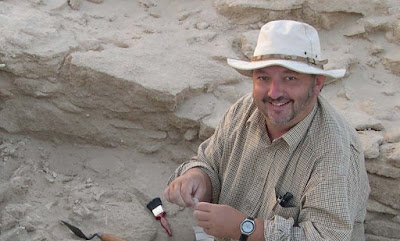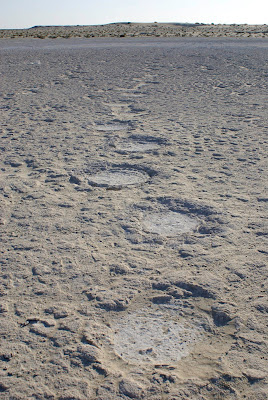Dr. Mark Beech's Top 10 Archaeology Discoveries in the UAE: Part 1
At the end of our season
last year, we had the pleasure of a lecture from Dr. Mark Beech, on the UAE's
most prominent archaeologists, who gave us an overview of his top 10
discoveries during his time as a paleo-archaeologist in the UAE, from 1994,
when he first fell in love with the country, to the present day.
Dr. Beech is of course
well known as a member of the team that discovered the Sir Bani Yas church and
monastery complex, which now numbers 40 sites, among them courtyard houses, a
monastery and villas. (Incidentally, the site was first discovered by an ENHG
member, Caroline Layman, who found plaster in a llama pen on the island during
a joint ENHG-DNHG field trip!)
However, many of us are
not aware of Dr. Beech’s ground-breaking discoveries in paleo-archaeology, which
put the UAE on the map for some very significant finds. In this post, then, we
will look at numbers 6-10 on his list of top 10 discoveries. We guarantee
you’ll learn something you didn’t know before…
Ruwais
Many of the finds in the
UAE are discovered through oil surveys, and the Ruwais site is no exception.
This site in the Western Region is rich with more mammalian fossils than any
other site in the Arabian Peninsula, with the first discoveries in 2002.
Artist rendering by Gemma Goodall, found here.
During the Late Miocene,
around 68 million years ago, Abu Dhabi was a little different! The Western Region was covered in trees, with
slow-moving, large rivers flowing through it, much like East Africa today.
Through this verdant paradise stomped a four-tusked elephant almost 3 metres
high at the shoulder...
Dr. Beech was part of a
team that excavated and transported a tusk of this gigantic creature, perfectly
intact and measuring 2.54 metres long. It had to be encased in a
specially-designed crate for transfer to the Environment Agency, where the team
promptly named their species Stegotetrabelodon Emiratus.
Umm Al Ashtan
Not far away from the
Ruwais site were found an intact pelvis, femur and tibia of the mighty
stegotetrabelodon in the remains of an ancient forest with 15-metre tree roots
and gigantic trunks. This permitted the ADIAS team to gather an even clearer
picture of what the creature looked like.
Drawing from here
Mleisa Site 1
However, it was a
tip-off from an Emirati man living in the area that alerted the team to an
elephant trackway of the late Miocene period. He called them ‘dinosaur prints,’
but they were in fact the earliest evidence of herding behaviour for elephants,
showing separate tracks for bulls and mother-child groups, which brought the
discovery to international prominence.
Photo from 'Fossils of Arabia' blog, here.
These patterns could be clearly seen in aerial
panoramic photographs, which the team painstakingly assembled by kite in those
pre-drone days.
Photo credit: Nathan Craig, found here
Another site dating to
the Late Miocene, the Shuwaihat site abounds in everything from elephants to
tiny fossils. The team found teeth from cane rats, which still exists in West
Africa, and which Dr. Beech calls a ‘guinea pig on steroids,’ as well as a
protohummus dango, so called by the team because its teeth look like squashed
chickpeas (hummus is Arabic for chickpea). They also found teeth from a guenon
monkey, the first such find outside of Africa, and a small, squirrel-like
animal that is still being identified.
The rat tooth is the brown, pebble-like object in the middle. It was found by sifting through tonnes of sand to find tiny animal remains.
Both photos from the 'Fossils of Arabia' blog, here.
Jebel Barakah
This is where Dr.
Beech’s discoveries begin to abut on human history, in the Middle Paelolithic,
a mere 150,000-35,000 years ago, or ‘two weeks’ in paleological time, as he
said. Returning to a site previously excavated by Sally McBrearty in 1991, the
team found more clusters of sites where stone tools made with the Paleolithic
Levallois technology were used, and where Neanderthal and homeo Sapiens
mingled.
Drawing from the Environmental Atlas of Abu Dhabi Emirate, here.
There was no Arabian
Gulf at the time. Instead, an ancient river emptied into the Gulf Basin, and
groups of nomadic hunters would hunt and slaughter the animals that gathered
around ancient lakes in the area, using stones gathered from the top of the
mountain. These finds, along with tools found in Saudi Arabia, support the Out
of Africa theory, with ancient nomads wandering along the Southern coast and
crossing the Bab Al Mandeb into what is now Yemen.
We will detail Dr.
Beech’s top 5 sites in another post which will take us into early human
settlements in the UAE, but in the meantime, let us enjoy the idea of Abu Dhabi as a lush
riverland crossed by giant, four-tusked proto-elephants!









Comments
Post a Comment